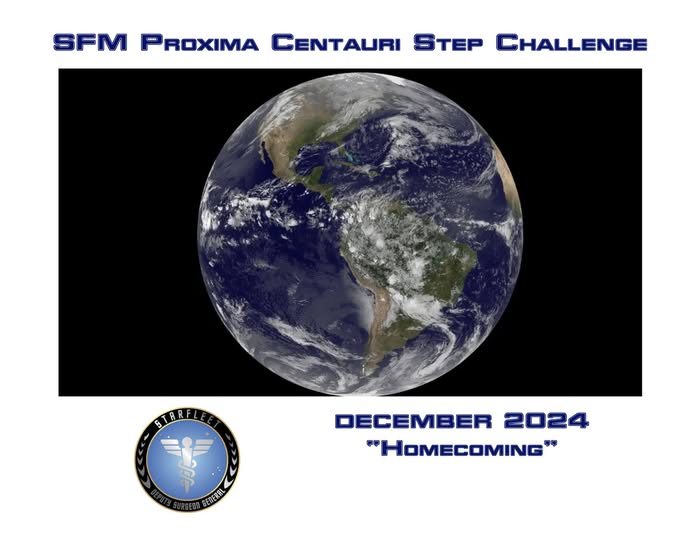There are currently 2 challenges in progress at STARFLEET Medical:

There will occasionally be monthly challenges, for instance, this month we may give double pages read for:
PLEASE TELL YOUR FRIENDS…AND TOGETHER WE CAN ALL REACH FOR THE STARS, ONE PAGE AT A TIME.

STARFLEET PROXIMA CENTAURI STEP CHALLENGE
Description: Walking can offer numerous health benefits to people of all ages and fitness levels. It may also help prevent certain diseases and even prolong your life. Walking is free to do and easy to fit into your daily routine. All you need to start walking is a sturdy pair of walking shoes. Read on to learn about some of the benefits of walking – (link)
Each month, we will travel along another leg of our journey to explore and establish a human colony in the Proxima Centauri system. At 4.25 light years distance, Proxima Centauri is the closest star system to our own Terran system. Research has shown that one of the planets in the Proxima Centauri system exists within the habitable zone of that star. We aim to travel there and establish the first extra-solar system human colony on that planet.
Each month’s new destination and step turn in dates will be announced on the SFI Members Only, Fleet/Regional STARFLEET Medical and Regional Fleet Facebook groups, as well as on the medical channel on the SFI Discord server.
After 8.4 light years of travel, (79.5 Trillion kilometres 49.4 trillion miles) on the odometer, the sight of that beautiful blue-green marble in the sea of black outside the forward viewscreen is a welcome sight. The Earth has never appeared so beautiful to me as it does today.
We’ve worked hard, overcome unexpected challenges as a crew and have successfully established the first extra-solar human colony in history. What’s more, we completed our mission without any casualties. As Commander of this mission, I could imagine no greater achievement.
I want to thank each and every one of you for your contributions to this incredible journey. Be proud of what you’ve accomplished!
Now let’s dock this ship that’s been our home for so many years. I’m eager to smell the roses and get a cheeseburger!!!
As a participant, you will keep track of your own steps through interstellar space using an app, a smart watch, a pedometer, etc. and submit your steps to your Regional Assistant Surgeon General. The schedule for December will be:
Week 1: December 1st to 6th
Week 2: December 7th to 13th
Week 3: December 14th to 20th
Week 4: December 21st to 31st
Once the week ends, you will total up the steps you have travelled over that period. You will then have 48 hours to submit those steps to your Regional ASG (ie. Week 1 ends on Friday, May 10th, therefore you have until Midnight PST on May 12th to submit your steps). Any steps submitted after that time will not be accepted. Please submit steps and only steps, no other units will be accepted. Here is a handy conversion guide: (link)
If you do not know who your Regional ASG is, please consult the following website:
https://medical.sfi.org/office-of-the…/serving-officers/
If your region does not have an ASG, please submit your steps using the following form:
https://docs.google.com/…/1FAIpQLSeOFfOYPqv…/viewform…
Settle in for our long crossing through interstellar space. It will probably be very quiet but with any luck, we may see one or two more familiar objects out there!!!!!!
If you do not know who your Regional ASG is, please consult the following website:
https://medical.sfi.org/office-of-the-surgeon-general/serving-officers/
If your region does not have an ASG, please submit your steps using the following form:
https://docs.google.com/…/1FAIpQLSeOFfOYPqv…/viewform…